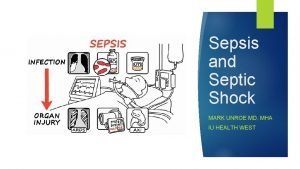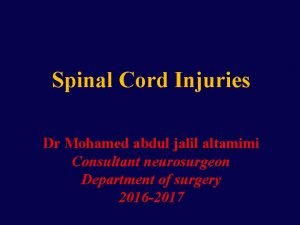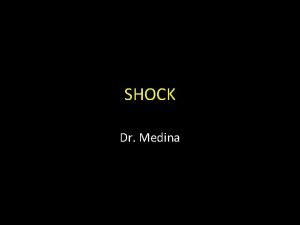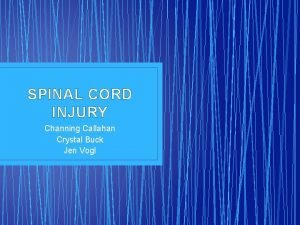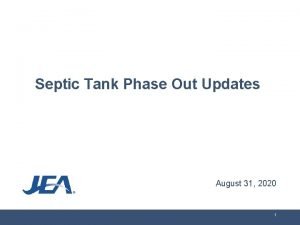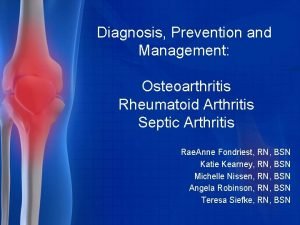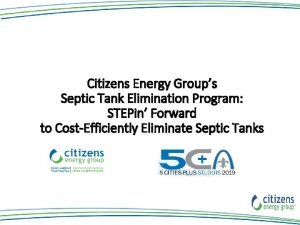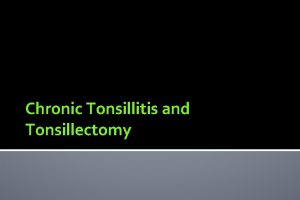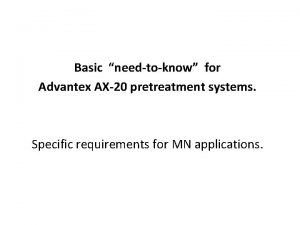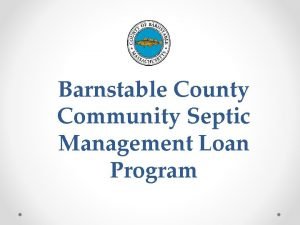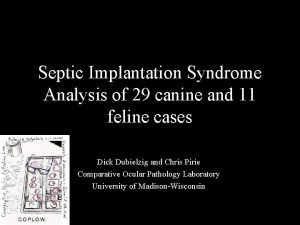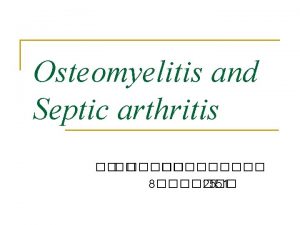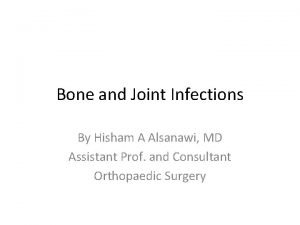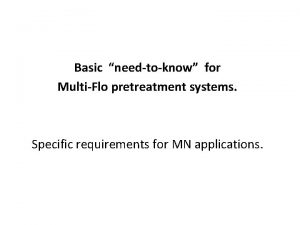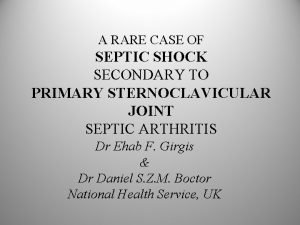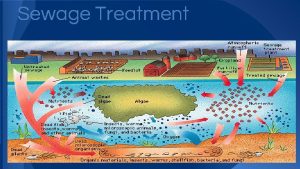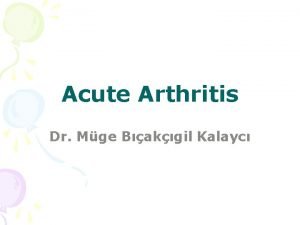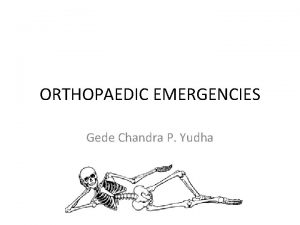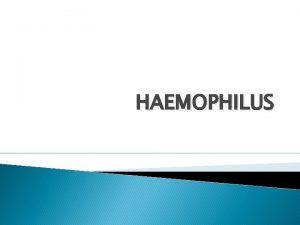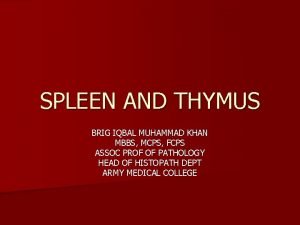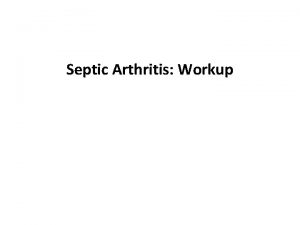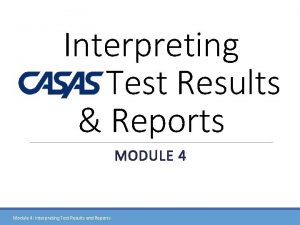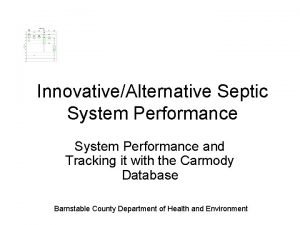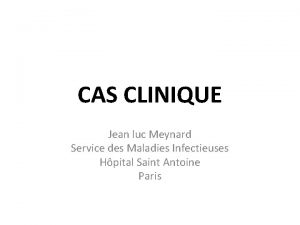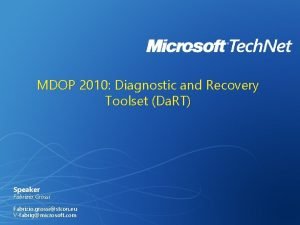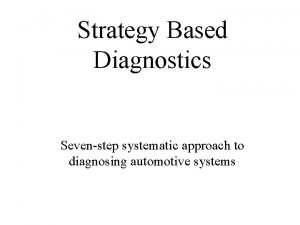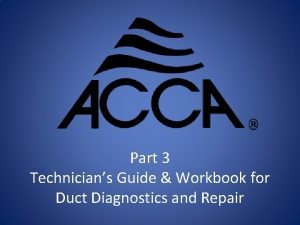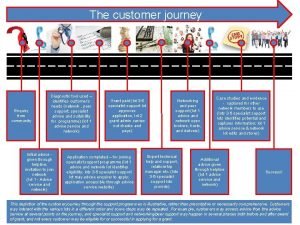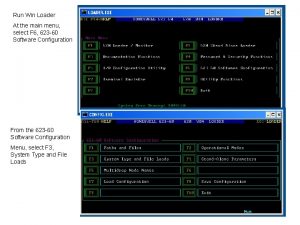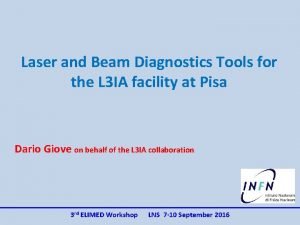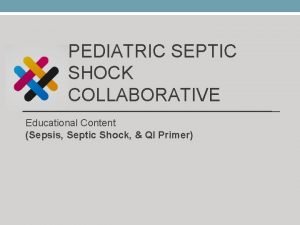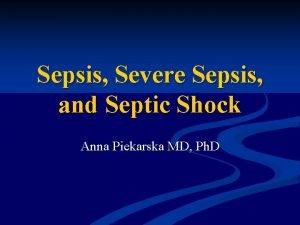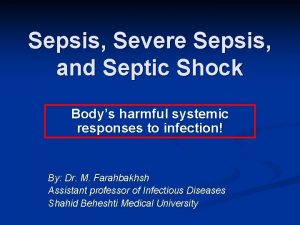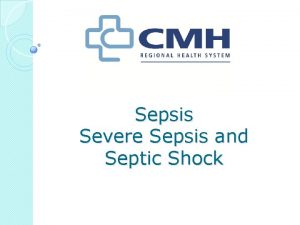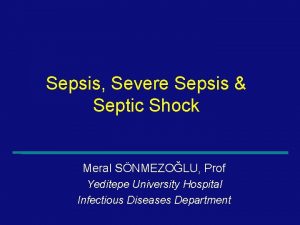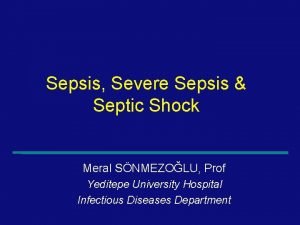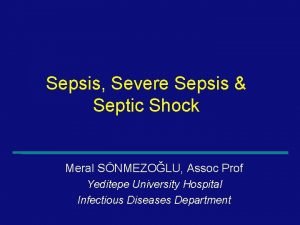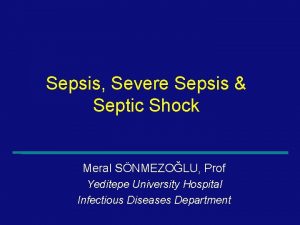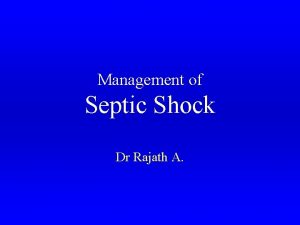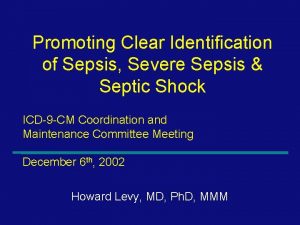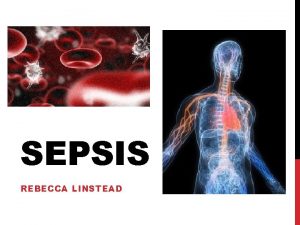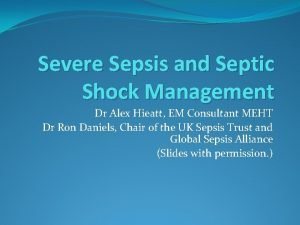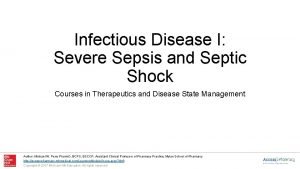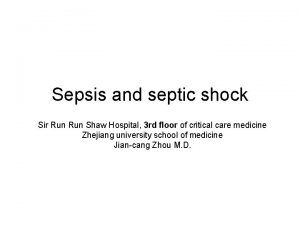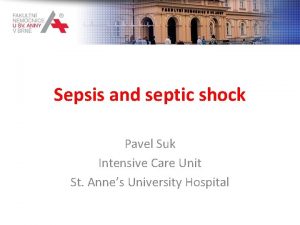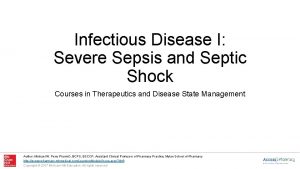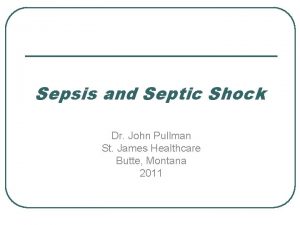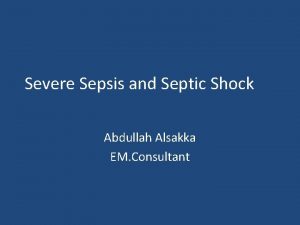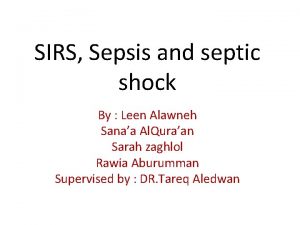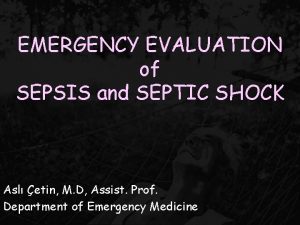Diagnostics and treatment of sepsis and septic shock













































- Slides: 45

Diagnostics and treatment of sepsis and septic shock MUDr. Roman Stebel Department of Infectious Diseases University Hospital Brno

Principal points of the presentation. . . sepsis from an infectologist’s viewpoint • Sepsis and septic shock: definition + history of the term • Clinical image and diagnostics • Patophysiological aspects of sepsis • Therapeutic algorithms • Case studies • Precautions • Discussion 2

History of the term “sepsis” “Sepsis is blood poisoning (by sepsins from rotting flesh)” … approx. 1800 “Sepsis is replication of bacteria in the blood” … approx. 1900 “Sepsis is a state where a lesion has formed in the organism that is periodically or continuously releasing bacteria into the bloodstream. This produces general symptoms of a severe condition, while local symptoms caused by the lesion lose significance” … Schottmüller, 1914 “Sepsis is a disease triggered by the presence of microbes, but caused by immune mechanisms of the body itself. The response to infection kills the patient sooner than the microbes alone would” … since approx. 1980 3

Epidemiology of sepsis • The leading cause of death from infectious diseases • 30 million patients annually, 25– 30% of them die • The cause of 30– 50% of all hospital deaths • Patient with sepsis has 6– 10 x higher risk of death than a patient with myocardial infarction and 4– 5 x higher risk than a CVA patient. • There are only a few conditions with such ↑ mortality • Long-term consequences – physical, mental and cognitive, disability. . . • Financial costs – sepsis treatment costs = 5. 2% of total healthcare costs in developed countries! 4

Sepsis: the development of modern definition Sepsis-1 (1991, Roger Bone) Systemic Inflammatory Response Syndrome (SIRS) criteria: 1) Body temperature < 36°C or over 38°C 2) Tachycardia > 90 beats/min 3) Tachypnea > 20 breaths/min 4) Leukocytosis over 12, 000/µL or leukopenia below 4000/µL more than 10% of immature neutrophil forms (bands) or Sepsis = infection + 2 of 4 SIRS criteria DEFINITION DISADVANTAGES → High number of false positive (A) and false negative (B) sepsis cases A) Presence of SIRS criteria during infection – frequent physiological (desirable) reaction even to a trivial infection (e. g. acute tonsillitis, UTI, erysipelas) B) Seniors, immunocompromised patients = low activation of proinflammatory processes, will not meet SIRS criteria even with a fully advanced sepsis (immunosenescence) → “Dilution effect” – false incidence rise and mortality drop = loss of “emergency” 5

Sepsis: the development of modern definition Sepsis-2 (2001) → SIRS criteria with a number of added clinical, metabolic and laboratory deviations: • Altered consciousness (GCS) • Hypotension • Hyperglycemia in patients without DM • CRP and procalcitonin elevation • Newly originated oliguria, edemas, positive fluid balance • Coagulopathy, thrombocytopenia. . . and more → Still bigger chaos, even lower specificity when diagnosing sepsis… Severe sepsis = infection + SIRS + acute organ dysfunction Septic shock = sepsis + hypotension non-responsive to fluid resuscitation ← Detailed specification of non-infectious SIRS causes 6

Sepsis: the development of modern definition Sepsis-3 (2016) → Focus on differentiating non-complicated infections from sepsis (↑ specificity) → Effort to early identify patients at risk of death (↑ sensitivity) → On the basis of a retrospective study of 1. 3 million patients Sepsis is a life-threatening organ dysfunction caused by deregulated response of the host organism to infection. → SIRS concept abandoned; it can help discern infection, but not necessarily → Term “severe sepsis” replaced by sepsis (as such); (organ dysfunction is essential) → Infection accompanied with organ dysfunction → sense of urgency → “Gray zone” – sepsis as other acute conditions’ complication, infection in polymorbid patients with preexisting organ dysfunction… Septic shock (SS) is a sepsis complicated by hypotension that, despite fluid resuscitation, requires vasopressor use to achieve MAP > 65 mm. Hg, with concurrent serum lactate elevation > 2 mmol/L. → Hospital mortality of SS exceeds 40%! 7

Adapted from: Matějovič M, Sepse a její nová definice, Postgrad Nefrol, 2017 8

Sepsis-3 – what does it bring to practice? The new definition emphasizes 3 key steps in care of patients with infection: 1) Confirmation and early treatment of infection 2) Acute organ dysfunction assessment → risk stratification, identification of sepsis 3) Identification and treatment of hypotension → crucial for prognosis of patient with infection Organ dysfunction assessment → Sepsis-related Organ Failure Assessment (SOFA) • Respiratory function (Pa. O 2/Fi. O 2) • Coagulopathy, thrombocytopenia • Hepatic and renal function (bilirubin, creatinine, oligo/anuria • Hypotension (MAP < 65 mm. Hg) or vasopressor requirement • State of consciousness (GCS) → 0– 4 points scale, the worst parameter over 24 hrs, ICU environment Simplified version for EMT, admission offices, standard wards → q. SOFA (quick) • Systolic BP ≤ 100 mm. Hg (1 point) • Tachypnea > 22 breaths/min (1 point) • Altered consciousness (GCS < 15) (1 point) → 2 and more points = high probability of sepsis in a patient with infection! 9

Diagnostics – confirming infection 1) “Head-to-toe” clinical examination → Febrilities, chills, shivers, hypothermia (in seniors, infections often without fever!) → Altered consciousness – apathy, confusion, restlessness, refusing food and fluids, delusional state → very often the first non-specific symptom of infection in geriatric patients → Infections in polymorbid patients typically lead to decompensation of chronic comorbidities – cardiac decompensation, COPD exacerbation, arrhythmia… (“general deterioration”) 2) Acquisition of medical history (if possible) → Previous hospitalizations, long-term care centers, ATB therapy, nursing homes → presuming “hospital” bacterial strains, obvious primary insult (surgery, trauma) → Travel in personal history (imported infections, MDR bacteria, vaccination) → Check available microbiology tests in history – e. g. repeated ESBL strains infections… → Allergies, ATB intolerance, data on Clostridium difficile infection in medical history 10

Diagnostics – confirming infection Pneumonia Urinary infection Erysipelas Purulent arthritis Auscultatory finding, dyspnea, chest pain, cough Dysuria, back and lower abdomen pain, urine color Skin erythema, warmth, edema, tenderness (face, lower limbs) Edema, erythema, joint pain, exudate Neuroinfection Cephalea, meningeal irritation, photophobia, disturbance of consciousness Gastroenteritis Abdominal pain, loose stool, nausea, vomiting Diarrheas can be often secondary to other infections! Pressure sore infections Pressure sore contamination with stool, urine Intraabdominal infection Infectious endocarditis Gynecological infections Abdominal pain, peritoneal irritation, absent peristalsis Seniors – atypical acute abdomen course without peritoneal irritation! Artificial valve, PM/ICD electrodes, new murmur, septic embolizations into skin and organs, cardiac failures Vaginal discharge, lower abdominal pain, puerperium or induced/spontaneous abortion in medical history. . . 11

Diagnostics – confirming infection 12

Diagnostics – confirming infection 3) Laboratory examination: Blood count + DIFF • Leukocytosis (leukopenia) • Signs of leukocytic activation (coarse granulation, bands, left shift, NLR) • Thrombocytosis (abscesses) x thrombocytopenia (G-negative infection) • Anemia Coagulation (PT, a. PTT, fibrinogen, AT, D-dimers) → Frequent coagulopathy (increased INR), but sepsis is essentially a procoagulation condition! Biochemistry • Acute phase reactants (CRP. . . ) • Hypoalbuminemia • Hyponatremia + other electrolyte dysbalances (hypophosphatemia) • Hyperglycemia • Increased urea waste (proteocatabolism) • Hepatopathy (accompanying SIRS x infection localization to the hepatobiliary area? ) • Inflammatory urine sediment Acid-base balance → Metabolic acidosis, hypoxemia, hypercapnea, serum lactate 13

Diagnostics – sepsis markers Interleukin-6 (IL-6) → Proinflammatory cytokine, produced by macrophages, polymorphonuclears → Controls acute phase proteins production in hepatocytes, including CRP (a step ahead of CRP) → Rapid dynamics, peak after 2 hrs, level in 48 hrs, correlates with mortality → Level correlated with the extent of inflammatory reaction, positive also in “common” infections → Non-specific for infection (positive in ARDS, acute pancreatitis, malignancies…) → Immunosuppressive treatment (incl. corticoids) reduces level → Suitable for neonatal infection/sepsis diagnostics C-reactive protein (CRP) → Acute phase protein, produced by hepatocytes (after IL-6 stimulation) → Activates the complement, opsonization factor in phagocytosis… → Increase after 6 hrs, peak in 48 hrs → High negative prediction, but production is affected by IS treatment → Does not differentiate condition severity, level does not correlate with mortality or severity of sepsis → Non-specific, a number of non-infectious causes (malignancies, autoimmune diseases…) 14

Diagnostics – sepsis markers Procalcitonin (PCT) → Physiologically produced by thyroid gland C-cells (prohormone of calcitonin), → In pathological conditions after bacterial toxin (LPS) and cytokine stimulation – ubiquitous PCT production by many tissues (adipocytes, muscles, hepatocytes, lungs…) → Immune response modulator, chemokine function (monocytes migration…) → Increase after 4 hrs, maximum in 24 hrs → Bacterial infection diagnostics in immunosuppressed patients (without IS influence) → Best for infectious and non-infectious SIRS differentiation, etiology of fevers of unknown origin → Therapy monitoring – ATB effect, de-escalation → Early identification of infectious complications in the critically ill → Many non-infectious PCT elevation causes are known to-date: • Medullar carcinoma, C-cell carcinoma, heat stroke, polytrauma, cardiogenic shock, CPCR • Physiological elevation in the first days of life (not suitable for neonatal infections) 15

Diagnostics – sepsis markers Presepsin (PSEP) → s. CD 14 -ST, a free glycoprotein fragment expressed on monocytes and macrophages → CD 14 receptor – interaction with bacterial surface structures after binding of CD 14 to bacterial LPS complex → activation of intracellular inflammatory response. → Cleaving CD 14 (lysosomal enzymes, Cathepsin) → soluble fragment = presepsin → Diagnostic marker of sepsis severity, mortality predictor in septic patients → Elevation in bacterial infections sooner than CRP and PCT, no influence of IS medication → Sepsis monitoring, alternative to PCT, diagnostics with POCT (outpatient) → Highly sensitive postoperative infection marker (others ↑ in reaction to the procedure) 16

Diagnostics – sepsis markers 17

Diagnostics – microbiology Microbiological screening 1) Hemoculture – always when sepsis is suspected (not done in about 1/3 of sepses!) 2) Further biological material → based on clinical finding (presumed origin) → Airway infection: sputum, endotracheal aspirate, BAL fluid, Pneumococcus and Legionella Ag → UTI: mid-stream urine, urinary catheter sample, nephrostomy → Neuroinfection: CSF collection (cytology, biochemistry, cultivation, PCR) → Diarrhea: stool for obligatory intestinal pathogens, C. difficile toxins → For deep infections/collections: percutaneous aspiration (centesis) → During surgical drainage/procedure: always fluid material (+ microscopy) (Swabs for epidemiological purposes (throat, nose, perineum) – MDR colonization) Besides cultivation – possible rapid detection of multiple pathogens by means of PCR, including pan-bacterial and pan-mycotic diagnostics (16 S-r. RNA) 18

Diagnostics – microbiology Hemocultures → Collection before ATB initiation (bactericidal effect on samples even several minutes after ATB!) → Vessel selection: aerobic (P. aeruginosa, Candida), anaerobic: strict anaerobes, viridising streptococci, 1 pair (concurrent collection) = 1 hemoculture (!) → 1 HMK is not enough, ideally 2 to 3 sets, sequential collection, increase of temperature/shivers → In patients with CVC, at least one hemoculture from the catheter, other from periphery → Sepsis with positive hemoculture is observed in only 30– 40% of cases → Vessel can be also used for CSF, centesis fluid, exudate… 19

Diagnostics – confirming infection 4) Imaging and other auxiliary methods → On principle, first use simple, non-invasive and (if possible) inexpensive methods 20

Diagnostics – confirming infection Investigating unclear origin of infection → Use of radionuclide imaging methods • Scintigraphy with labeled leukocytes / anti-granulocyte antibodies (SPECT) • Positron emission tomography combined with morphological exam (PET/CT, PET/MRI) 21

Diagnostics – organ dysfunction → The goal is to identify the state as “sepsis” and quickly stratify patient risk → Some manifestations of altered hemodynamics and tissue perfusion in severe infections are evaluable also clinically (skin, peripheral tissues): 1) Marbling (livedo reticularis, mottled skin) → Spotty skin discoloration, often on the lower limbs (knees), also on the fingers and toes, around auricles… → Affected area size from the knees to the periphery correlates with mortality (score 0– 6) 2) Delayed capillary return → Fingernail bed perfusion restoration rate after 5 -second compression, limit values 2. 5– 4. 5 s → Correlates with organ dysfunction severity, predicts mortality 3) “Cold periphery” → Temperature difference between fingers and forearm (subjective or exactly measured) → Difference > 4°C is a sign of significant peripheral vasoconstriction 22

Diagnostics – organ dysfunction 23

Diagnostics – organ dysfunction 24

Diagnostics – organ dysfunction 4) Serum lactate concentration → The most important cellular metabolic stress marker → Created by anaerobic glycolysis – pyruvate conversion by LD → Sepsis – adrenergic stress response, increased glycolysis exceeding mitochondrial oxidative capacity, concurrent endotel damage, microcirculation disturbance, tissue hypoxia → lactate acidosis → Even 2. 1– 3. 9 mmol/L values are associated with increased mortality, risk sharply rises with value > 4 mmol/L, normal value is a relative guarantee of physiological reserve → Important in patients with ”hidden shock” – normotensive patients without acute organ dysfunction signs; lactate elevation together with hyperthermia are strong predictor of early development of septic shock (within 72 hrs) → Simple venous blood test along with AB balance – POCT (rapid processing necessary) 25

Patophysiological aspects of sepsis Metabolic changes during sepsis Infection: standard fight with bacteria → Membrane damage (lysozyme, complement) → Loss of bacterial cells restriction → Loss of membrane potential → energy outage → Phagocytosis (facilitated by the complement or antibodies) Sepsis: a pitched fight, even at the cost of self-damage → Metabolic pathways (energy source) blockage: • Competition for iron ions (necessary for respiratory chains) • Blockage of respiratory chains Fever → Universal reaction to any generalized infection (not just sepsis) → A desirable reaction: elevated temperature inhibits the replication of many bacteria and viruses, also has a signal function – increases antibody production and stimulates phagocytosis • Infected lizards will survive in warm environment, but die in the cold • Antibiotics-treated rabbits with infection have higher mortality • Administration of antipyretics in humans extends the course of influenza 26

Patophysiological aspects of sepsis The fight for iron → Fe is a growth factor for a number of microbes → Anti-infection immunity “sequesters” Fe ions to safety (out of the reach of bacteria) → During active infection, anemia must not be treated by administration of Fe-containing drugs → Substitution by transfusion is necessary (deleucotized erythrocyte concentrates) 27

Patophysiological aspects of sepsis Bacterial respiratory chain blockade (hypothesis) → Most pathogenic bacteria have aerobic metabolism Various nutrients → acetyl-Co. A → Krebs cycle → NADH, FADH 2 Membrane → ion boundary Proton gradient → ATP source → During sepsis, the organism produces cytochrome-inhibiting substances → It keeps bacteria from using the most effective energy source, but at the same time blocks its own mitochondrial function! Indirect proofs: • Mitochondrial damage during sepsis was demonstrated (cardiodepressant factor) • Complex metabolic changes occurring in sepsis can be explained by mitochondrial function outage. • This can also explain the origin of multiple organ failure (MODS, MOF) as well as the development of polyneuromyopathy as a consequence of sepsis 28

Patophysiological aspects of sepsis Metabolic changes during sepsis → Energy output at sepsis ≈ heavy physical labor! → Severe infection disables regular food acquisition (gathering, hunting), but also the digestive processes → internal sources utilization Energy sources for fasting (male, 80 kg): liver glycogen (75 g) muscle glycogen (150 g) body fat (15 kg) mobilizable protein (6 kg) 4 hours only while working 90 days 15 days Lipids are utilized only in mitochondria, and those do not work during sepsis Amino acids are the only available energy source → septic autocannibalism (≈ 300 g of protein/day) The demand for amino acids during sepsis is extreme → Energy source → Production of PMN, acute inflammation phase proteins, antibodies → Regeneration of damaged tissues 29

Therapeutic algorithms of sepsis Sepsis = “medical emergency”, an urgent state requiring prompt initiation of therapy Fundamental “Sepsis treatment triad”: 1. Antimicrobial treatment 2. Infection source control 3. Fluid resuscitation → The importance of rapid therapeutic reaction → Administration of intravenous ATB therapy in septic shock and sepsis within 1 hour 30

Therapeutic algorithms of sepsis 1) Antimicrobial treatment → Use of broad-spectrum ATBs, one or more to cover all probable agents → Dosage of bactericidal ATBs at the upper limit (changes in distribution volumes) When selecting ATBs, you must consider: → anatomical localization of the infection (ECF, ICF, vasculature, skin, bones, CNS…) → present immune disturbance (splenectomy, HIV, neutropenia, presence of CVC/PUC) → comorbidity (CHRI), drug interaction, adverse reactions, form of application… → epidemiological history: was the patient at home / in a hospital, the last known infection or colonization, ATBs received in the past 3 months Known focus of infection enables more targeted approach: → Urinary or biliary tract – anticipated G– bacteria → Infectious endocarditis, wound infection, spondylitis, osteomyelitis > 80% G+ etiology → Consider the possibility of yeast sepsis – namely with IS (neutropenia, chemotherapy, transplantation, prolonged ICU hospitalization…) 31

Therapeutic algorithms of sepsis 2) Infection source control → Infection focus removal (if known and accessible): abscess drainage, infected necrotic tissue debridement, surgical revision… → Removal of possibly infected invasive ports (CVC, PUC) → Consider the possibility of foreign material infection (ICD electrodes, implants…) → Also treatment of neutropenia (G-CSF), elimination of natural barrier impairments → A lesion should not be anticipated only with highly acute sepsis caused by encapsulated strains, particularly meningococcal sepsis, OPSI → In Staphylococcus aureus infections, a lesion must always be anticipated; secondary lesions are formed byhematogenous spread (infectious endocarditis, abscess-forming pneumonia, endarteritis, osteomyelitis, abscesses, spondylodiscitis…) 32

Therapeutic algorithms of sepsis 3) Fluid resuscitation → Initial fluid resuscitation for hypotension or lactate > 4 mmol/L 30 m. L/kg balanced crystalloids in the first 3 hours → Allows time to get further patient information, collections etc. → Most patients need further fluids administration – governed by repeated status assessment (e. g. 150 m. L/hr crystalloids), colloids? Reassessment includes – blood pressure, HR, oxygen saturation, respiratory rate, temperature, urine output, CVP, hemodynamic parameters… If fluid administration does not stabilize circulation → VASOPRESSORS → Early circulation support with catecholamins in sepsis with hypotension = better prognosis → Drug of choice noradrenalin, refractory hypotension → add vasopressin → Dosage according to MAP (ideally > 70 mm. Hg, more in hypertonic patients!) → Monitor ECG (arrhythmia), arterial cannula (i. BP), hourly urine output, CVP… 33

Therapeutic algorithms of sepsis Corticosteroids → Always in corticodependent patients and in patients with adrenal dysfunction → In hypotension refractory to fluid resuscitation and vasopressors (increase of catecholamine effect on peripheral tissues) → Hydrocortisone 200– 300 mg/day (bolus x continuous) TED prophylaxis → Low molecular weight heparins (LMWH) → For circulatory instability, high vasopressor doses → continuous IV administration Gastroduodenal stress ulcer prophylaxis → proton pump inhibitors, H 2 receptor antagonists Early enteral nutrition, micronutrients, supplementing P, vit. C and B 1… Physiotherapy, ergotherapy, basal stimulation, chronic wound and pressure sore care… 34

Case study 1 ü Female, 64 years, history of liver transplantation due to PBC in 2014, type 2 DM on IIR, chron. IHD, CHRI, hypothyreosis, st. p. ischem. CVA in 2018, st. p. vir. hep. B… ü Immunosuppression with Advagraf 0. 5 mg/day (tacrolimus) ü Initially admitted to local internal medicine dept. for newly originated edema of the lower left limb, pain, erythema, gradually dark to livid, surgeon ruled out acute arterial occlusion, ATB therapy not initiated, pain controlled with opioids, lucid, walking, afebrile ü Initial lab. test Hgb 92, PLT 61, INR 1. 73, CRP 31, PCT 13. 2, urea 38, creat. 238 (long-term pancytopenia) ü Transferred to the Dept. of Infectious Diseases as susp. lower left limb erysipelas in an immunocompromised patient ü On admission BP 100/50, HR 85/min, RR 16/min, admitted to standard ward, for severe pain added Doppler of veins and arteries, hip X-ray, other locations heart + lungs X-ray, abdominal sono – no significant pathology, no abscess on the lower left limb, arteries patent, no DVT ü Initiated ATB therapy with IV clindamycin, crystalloids, analgesics

Case study 1

Case study 1 ü At night on the first hospitalization day – hematemesis – transfer to ICU, acute GFS: Mallory-Weiss syndrome, bleeding stigmata, esophagitis, grade 1 esophageal ulcer, recommended to adjust coagulopathy, EBR substitution, PPI, hemostyptics… ü Upon return from GFS somnolence, GCS 14, hypotension 70/40, hyposaturation, continuing ATB clindamycin, adjusted coagulopathy (Ocplex, FFP, EBD, antithrombin), cont. PPI, hemostyptics, crystalloids ü The next morning progressive disturbance of consciousness, GCS 8, severe hypotension, anuria, desaturation ü OTI and APV, circulation support with vasopressors – comb. noradrenaline + terlipressin, bolus of crystalloids + Gelaspan ü AB balance – severe metabolic acidosis, elevated lactate, repeated administration of bicarbonate (no effect)

Case study 1 ü Hemocultivation reported 3 x G– bacilli – ATB therapy changed to meropenem + amikacin, marbling, hematomas and hemorrhagic bullae on the lower left limb ü Chest X-ray check after OTI and CVC cannulation – non-homogeneous consolidation bilat. , dif. dg. possible ARDS ü Due to lasting circulatory instability, severe metabolic acidosis and anuria (secondary to CHRI) transfer to KARIM, initiated CVVHD ü Death within 24 of admission with clinical image of refractory septic shock, autopsy not indicated ü Urine and hemoculture show E. coli sensitive to common ATBs (history of repeated E. coli urinary infections…)

Case study 2 Ø Male, 37 years, in puberty examined at hematology for thrombocytopenia, leukopenia, hypersplenism, signs of portal hypertension, malignancy not determined Ø 7/2004 splenectomy (to resolve thrombocytopenia, histolog. exam. of the spleen, perioperative liver biopsy), case closed as idiopathic portal hypertension, did not attend further hematological follow-ups, vaccinations only per GP’s schedule Ø From early morning in 3/2017 vomiting, diarrhea, chills, shivers, fever 40 °C Ø At 2: 30 p. m. examined at EMS, received antipyretics, Torecan, susp. acute gastroenteritis, sent home Ø At 8: 20 p. m. , family drove him to hospital admission due to deterioration, lasting fever, somnolence, newly petechiae on the face and trunk 39

Case study 2 ü On admission: HR 134/min (SR), BP not measurable, RR 30/min, TT 38. 8°C, sat. O 2 91%, GCS 3 -5 -6 ü Spontaneous ventilation, centralization of circulation, petechiae on the face and trunk, map-like livid spots on the abdomen 40

Case study 2 Ø Venous accesses secured, fluid resuscitation with crystalloids, oxygen therapy Ø Ceftriaxon 4 g IV, Dexamed 16 mg IV administered for the working dg of IMD, noradrenaline for circulation support, RICU consultation – OTI, APV, analgosedation Ø Bradycardia follows, ECG shows ischemic changes with ST-T elevations V 1 -V 6, I, II, a. VL (assessed as secondary to shock state) Ø Transfer to KARIM, ATB therapy Ceftriaxon + Meropenem, complex resuscitation care, corticoids, blood derivatives, cont. LMWH, crystalloids + colloids… Ø At 1: 30 a. m. circulatory instability, bradycardia, according to bed-side TTE hypokinesis of both ventricles, inotropic support by dobutamine with small effect Ø At 1: 45 a. m. CPCR for circulatory arrest, asystolia, administered 9 mg adrenaline, isoprenaline, dobutamine, noradrenaline, considered ECMO Ø CPCR terminated after 45 minutes, death (5 hours after admission to hospital!) Ø Hemocultivation: Streptococcus pneumoniae serotype 6 C → dg. OPSI/OPSS 41

Precautions → Prevention of infections with high risk of progression into sepsis Care of patients after splenectomy (vaccination, ATB prophylaxis) → The spleen plays an important role in the capture and elimination of encapsulated bacteria circulating in the bloodstream (opsonization by means of Ig. M antibodies produced by memory B lymphocytes directly in the spleen) → Patients with hyposplenism/asplenia are at high risk of severe infections induced by pneumococci, haemophilus, meningococci (also malaria and babesiosis) → OPSI (Overwhelming Post-Splenectomy Infection) → OPSS (Overwhelming Post-Splenectomy Sepsis) Vaccine type: Vaccine against pneumococcal diseases Vaccine against meningococcal diseases Vaccine against Haemophilus influenzae b Vaccine against the influenza Recommended products: Prevenar 13®, (Pneumovax®) Against serogroup A, C, W, Y: Menveo® or Nimenrix® Against serogroup B: Bexsero® or Trumenba® Hiberix® Vaxigrip Tetra®, Influvac Tetra® Emergency ATB therapy (cefuroxim, amoxicillin/clavulonate, moxifloxacin) → ATB package dispensed to the patient should he/she get a fever while unable to go see a doctor 42

Conclusion – key points 1) Sepsis = “medical emergency”, a state requiring immediate initiation of diagnostic and therapeutic procedures including directing the patient 2) The patient may be sicker than he/she looks 3) Newly developed organ dysfunction → always consider an infection 4) Unexpected sudden deterioration → suspect sepsis regardless if the sepsis criteria are met (deterioration of ward patients) 5) sepsis can be modified by a pre-existing acute disease, chronic comorbidities, medication… 43

Conclusion – key points 6) Sepsis-3 = confirmation of infection + organ dysfunction assessment + identification of hypotension 7) Triage of patients with suspected sepsis: q. SOFA + peripheral hypoperfusion signs + lactate 8) hypotension – underestimated factor in the initial patient assessment, late correction of hypotension is a strong independent factor of mortality 9) Suspected sepsis – activate the process Standard ward → ICU, Admissions → Emergency Admissions, Department physician → Intensive care specialist 10) Do not waste time, the sooner adequate therapy begins, the better the prognosis 44

stebel. roman@fnbrno. cz
 Sepsis 2 vs sepsis 3
Sepsis 2 vs sepsis 3 Site:slidetodoc.com
Site:slidetodoc.com Normovolemico
Normovolemico Spinal shock vs neurogenic shock
Spinal shock vs neurogenic shock Spinal shock vs neurogenic shock
Spinal shock vs neurogenic shock Spinal shock vs neurogenic shock
Spinal shock vs neurogenic shock Jea septic tank phase out
Jea septic tank phase out Septic tank contamination groundwater
Septic tank contamination groundwater Symptoms of gonorrhea
Symptoms of gonorrhea Indianapolis septic tank elimination program
Indianapolis septic tank elimination program Septic squeeze test tonsillitis
Septic squeeze test tonsillitis Advantex septic system reviews
Advantex septic system reviews Barnstable septic loan
Barnstable septic loan Pickwickian syndrome in dogs
Pickwickian syndrome in dogs Septic arthritis complications
Septic arthritis complications Panhandle health septic
Panhandle health septic Septic arthritis antibiotics
Septic arthritis antibiotics Septic arthritis antibiotics
Septic arthritis antibiotics Bat septic system
Bat septic system Multiflow septic system
Multiflow septic system Puraflo peat septic system
Puraflo peat septic system Septic arthritis complications
Septic arthritis complications Doc's septic tank cleaning
Doc's septic tank cleaning Septic arthritis
Septic arthritis Haemophilus influenzae septic arthritis
Haemophilus influenzae septic arthritis Haemophilus ducreyi culture media
Haemophilus ducreyi culture media Example of gram negative cocci
Example of gram negative cocci Chemical oxygen demand principle
Chemical oxygen demand principle Spleniculi
Spleniculi Septic workup
Septic workup Septic
Septic Summit county septic permit
Summit county septic permit Rock solid precast
Rock solid precast Carmody septic
Carmody septic Urethritis reactive arthritis
Urethritis reactive arthritis Da toolset
Da toolset Mitel system administration and diagnostics download
Mitel system administration and diagnostics download Gm strategy based diagnostics
Gm strategy based diagnostics Duct
Duct Customer journey diagnostics
Customer journey diagnostics Loader diagnostics main menu
Loader diagnostics main menu Standard diagnostics korea
Standard diagnostics korea Laser beam diagnostics
Laser beam diagnostics Cristina brunet
Cristina brunet Birads grade
Birads grade Cole diagnostics jobs
Cole diagnostics jobs
